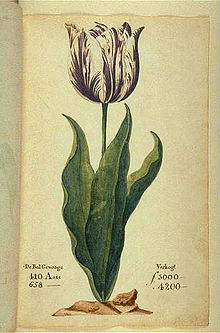When the Tulip Bubble Burst TULIPOMANIA
The Story of the World’s Most Coveted Flower
By Mike Dash
Crown Publishers

A tulip, known as “the Viceroy”, displayed in a 1637 Dutch catalog. Its bulb cost between 3000 and 4200 florins depending on size. A skilled craftsman at the time earned about 300 florins a year.[1]
Long before anyone ever heard of Qualcomm, CMGI, Cisco Systems, or the other high-tech stocks that have soared during the current bull market, there was Semper Augustus. Both more prosaic and more sublime than any stock or bond, it was a tulip of extraordinary beauty, its midnight-blue petals topped by a band of pure white and accented with crimson flares. To denizens of 17th century Holland, little was as desirable.
Around 1624, the Amsterdam man who owned the only dozen specimens was offered 3,000 guilders for one bulb. While there’s no accurate way to render that in today’s greenbacks, the sum was roughly equal to the annual income of a wealthy merchant. (A few years later, Rembrandt received about half that amount for painting The Night Watch.) Yet the bulb’s owner, whose name is now lost to history, nixed the offer.
Who was crazier, the tulip lover who refused to sell for a small fortune or the one who was willing to splurge? That’s a question that springs to mind after reading Tulipomania: The Story of the World’s Most Coveted Flower and the Extraordinary Passions It Aroused by British journalist Mike Dash. In recent years, as investors have intentionally forgotten everything they learned in Investing 101 in order to load up on unproved, unprofitable dot-com issues, tulip mania has been invoked frequently. In this concise, artfully written account, Dash tells the real history behind the buzzword and in doing so, offers a cautionary tale for our times.
The Dutch were not the first to go gaga over the tulip. Long before the first tulip bloomed in Europe–in Bavaria, it turns out, in 1559–the flower had enchanted the Persians and bewitched the rulers of the Ottoman Empire. It was in Holland, however, that the passion for tulips found its most fertile ground, for reasons that had little to do with horticulture.
Holland in the early 17th century was embarking on its Golden Age. Resources that had just a few years earlier gone toward fighting for independence from Spain now flowed into commerce. Amsterdam merchants were at the center of the lucrative East Indies trade, where a single voyage could yield profits of 400%. They displayed their success by erecting grand estates surrounded by flower gardens. The Dutch population seemed torn by two contradictory impulses: a horror of living beyond one’s means and the love of a long shot.
Enter the tulip. ”It is impossible to comprehend the tulip mania without understanding just how different tulips were from every other flower known to horticulturists in the 17th century,” says Dash. ”The colors they exhibited were more intense and more concentrated than those of ordinary plants.” Despite the outlandish prices commanded by rare bulbs, ordinary tulips were sold by the pound. Around 1630, however, a new type of tulip fancier appeared, lured by tales of fat profits. These ”florists,” or professional tulip traders, sought out flower lovers and speculators alike. But if the supply of tulip buyers grew quickly, the supply of bulbs did not. The tulip was a conspirator in the supply squeeze: It takes seven years to grow one from seed. And while bulbs can produce two or three clones, or ”offsets,” annually, the mother bulb only lasts a few years.
Bulb prices rose steadily throughout the 1630s, as ever more speculators wedged into the market. Weavers and farmers mortgaged whatever they could to raise cash to begin trading. In 1633, a farmhouse in Hoorn changed hands for three rare bulbs. By 1636 any tulip–even bulbs recently considered garbage–could be sold off, often for hundreds of guilders. A futures market for bulbs existed, and tulip traders could be found conducting their business in hundreds of Dutch taverns. Tulip mania reached its peak during the winter of 1636-37, when some bulbs were changing hands ten times in a day. The zenith came early that winter, at an auction to benefit seven orphans whose only asset was 70 fine tulips left by their father. One, a rare Violetten Admirael van Enkhuizen bulb that was about to split in two, sold for 5,200 guilders, the all-time record. All told, the flowers brought in nearly 53,000 guilders.
Soon after, the tulip market crashed utterly, spectacularly. It began in Haarlem, at a routine bulb auction when, for the first time, the greater fool refused to show up and pay. Within days, the panic had spread across the country. Despite the efforts of traders to prop up demand, the market for tulips evaporated. Flowers that had commanded 5,000 guilders a few weeks before now fetched one-hundredth that amount.
Tulipomania is not without flaws. Dash dwells too long on the tulip’s migration from Asia to Holland. But he does a service with this illuminating, accessible account of incredible financial folly.
Tulip mania differed in one crucial aspect from the dot-com craze that grips our attention today: Even at its height, the Amsterdam Stock Exchange, well-established in 1630, wouldn’t touch tulips. ”The speculation in tulip bulbs always existed at the margins of Dutch economic life,” Dash writes. After the market crashed, a compromise was brokered that let most traders settle their debts for a fraction of their liability. The overall fallout on the Dutch economy was negligible. Will we say the same when Wall Street’s current obsession finally runs its course?
MARK FRANKEL is executive editor of dads magazine.